TCM explores the Bigfoot Industries campus in Armstrong, British Columbia and discovers what Grant Bilodeau, President of Bigfoot, meant when he said, “It’s either a Bigfoot, or it’s not”. Hint: You can hit it with a hammer, and fit it without gimp. And it’s a secret.

Grant Bilodeau, President of Bigfoot Industries, made quite a stir in Truck Camper Magazine last July when he stated, “It’s either a Bigfoot, or it’s not.” He added, “If I see something on the production line or on a unit that isn’t fitting to the Bigfoot name, that’s the phrase I use with the team. It’s either right or it isn’t. There is no middle ground with me.”
That’s a bold statement in an industry that’s notorious for paying more attention to the bottom line than the production line. We’ve also heard comments like this before. Unfortunately, elements of the RV industry are known for talking the talk, but not walking the walk.
That said, there was something different about Grant’s comment; a conviction that compelled us to schedule a drive to Bigfoot headquarters in western Canada. Exactly what was Grant talking about?
Bigfoot Industries is located in Armstrong, British Columbia about three hours or 125 miles (200 kilometers) from the border in Washington State. The drive on Route 97 is nothing less than spectacular as you wind through mountainside shorelines of deep blue lakes. Do your best to not be in a hurry as you pass dozens of tempting fruit orchards, vineyards, wineries, and roadside stands overflowing with delicious apples, pears, peaches, apricots, cherries and plums.
This was our fourth visit to Bigfoot Industries having visited in 2007, 2010, 2015, and now 2018. As we chronicled in, “Bigfoot On the Move”, the original Bigfoot Industries was struck down during the Great Recession of 2008, and then methodically relaunched in 2010 by Grant and a devoted A-list team from the original company.
Without a doubt, Bigfoot’s inspiring return is one of the most triumphant stories of any RV manufacturer from that dreadful time period, and an absolute must read for anyone who cares about truck campers and the power of the human spirit.
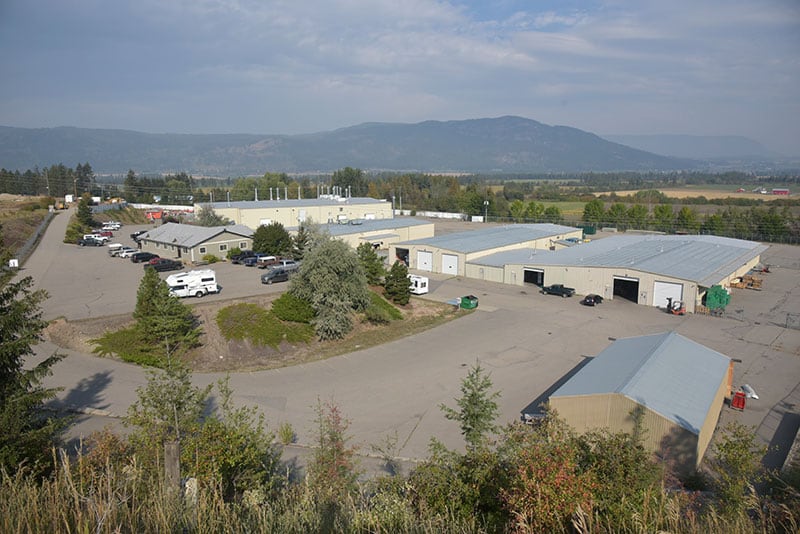
This photograph shows the entire Bigfoot Industries manufacturing complex including the main offices (left center), fiberglass shop (top center), production line (center with open bay door), and inventory warehouse (center far right). If you look closely you can spot our camper parked in front of the main offices. It’s a huge facility; easily one of the biggest in the truck camper industry.
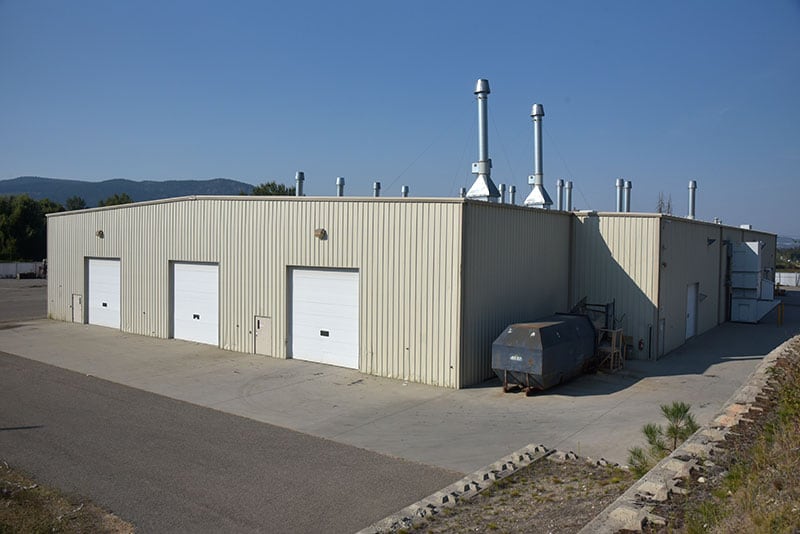
Bigfoot’s fiberglass shop is an extraordinary and purpose-built building. The inside of this building is even more impressive.
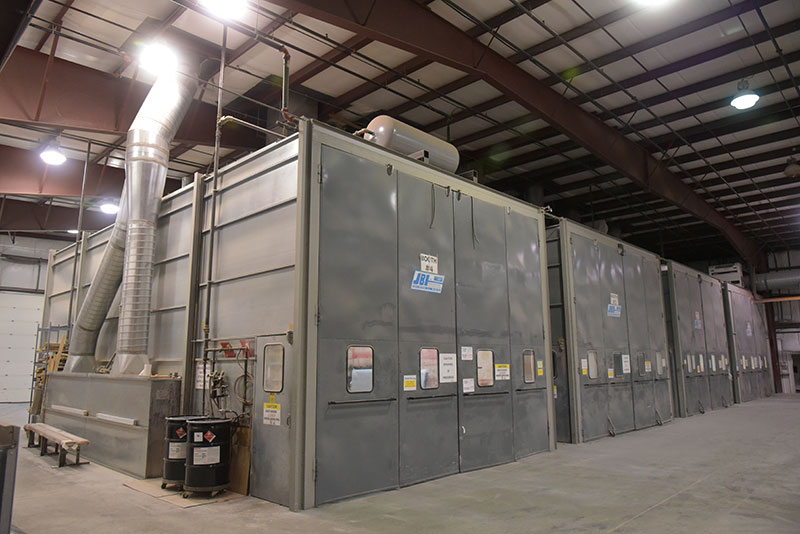
Towards the rear of the fiberglass shop are four large, enclosed and ventilated JBI spray booths. Manufactured in Osseo, Wisconsin, these spray booths feature advanced ventilation systems designed to keep the fiberglass technicians safe and fiberglass production as clean as possible.
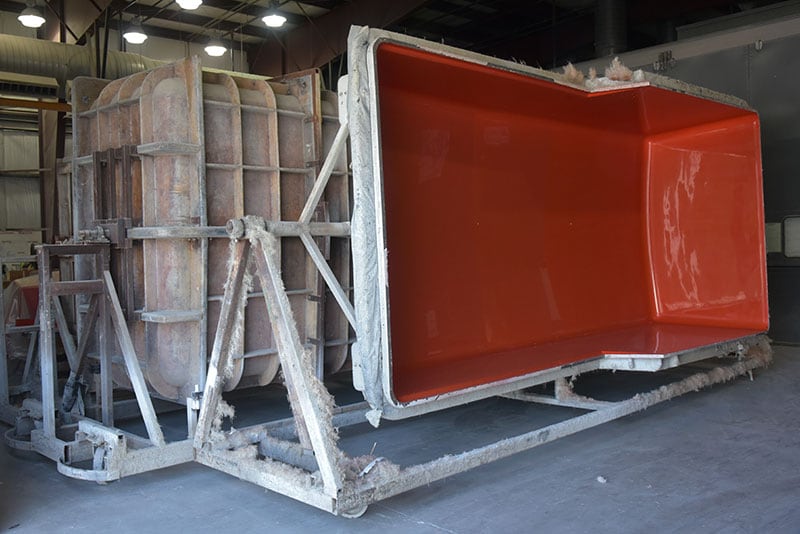
Immediately behind the spray booths is where Bigfoot stores their fiberglass camper shell, trailer, and shower stall molds. After each use, these molds are carefully inspected and maintained.
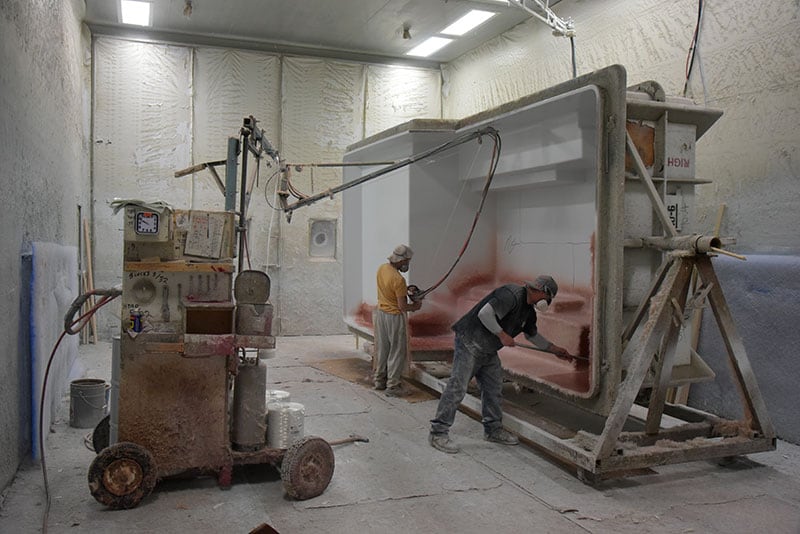
Fiberglass shells are produced by teams of two. One operator is responsible for gel coat and chopped fiberglass application. The other rolls the applied fiberglass, installs additional fiberglass and shell-strengthening materials, and monitors the quality and tolerances.
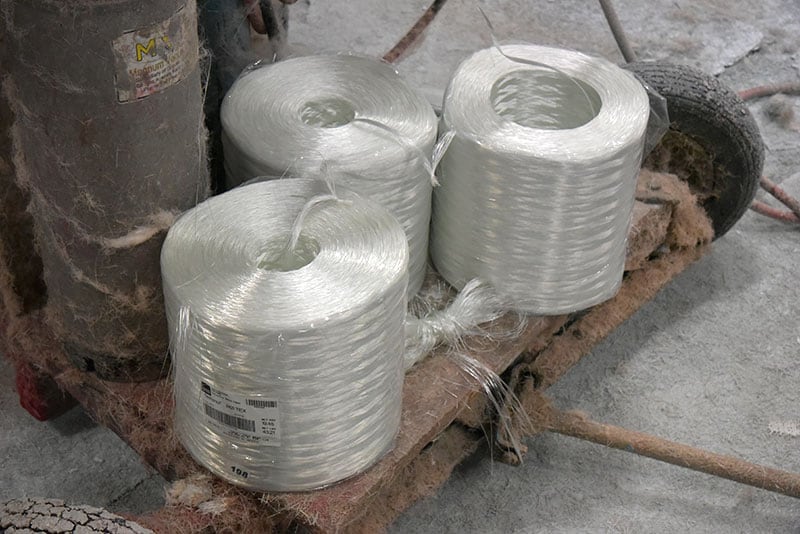
The cart holds three rolls of Owens Corning fiberglass, the same premium material used to manufacture Ranger Boats. The cart also carries the resin and anchors the pneumatic fiberglass gun system; hose, mast, and boom.
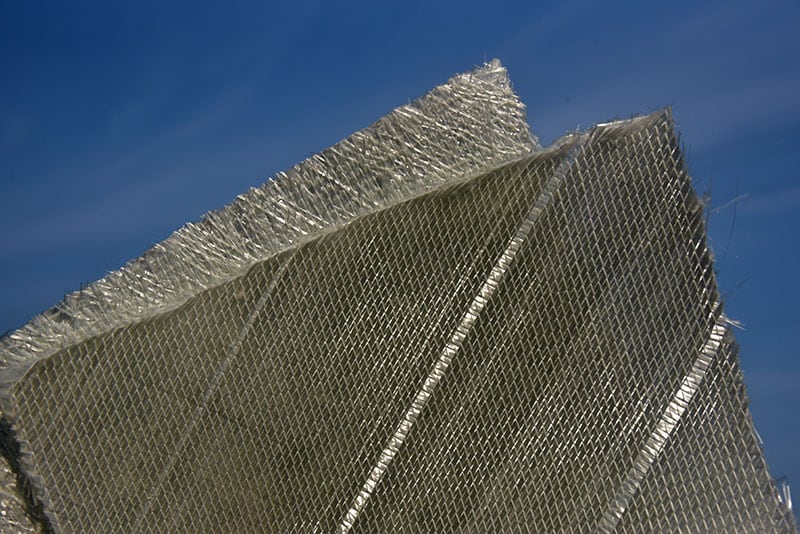
The majority of a Bigfoot fiberglass shell is built up from sprayed layers of chopped fiberglass and resin. For increased strength in key areas, additional layers of woven fiberglass are installed.
In the above photograph you can see two of the woven fiberglass types used during this process. The result is a lightweight, strong, and highly weather-resistant clamshell fiberglass exterior. No frame required.
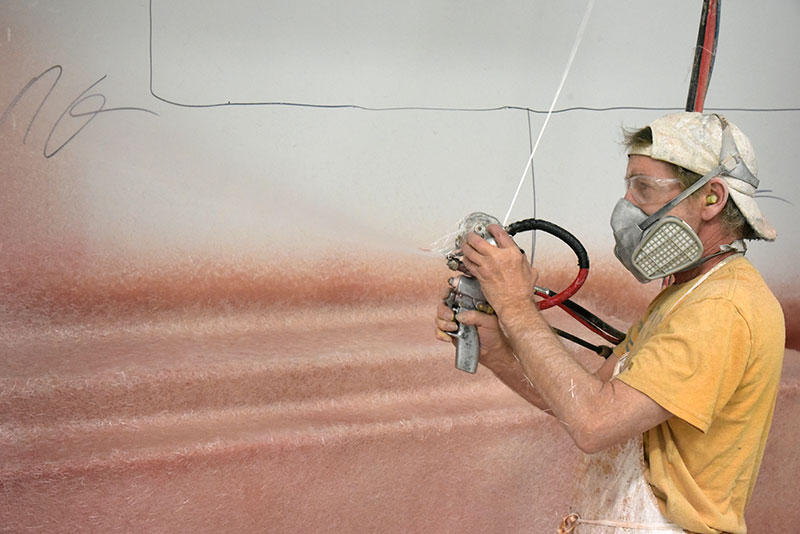
The chop gun operator has the critical job of applying the fiberglass and resin as evenly as possible for a uniform shell thickness. A uniform thickness is essential for proper structural integrity.
Talking to the Bigfoot production and management team gave us a profound appreciation for the skill and experience that goes into this effort. Suffice it to say there are many decades of experience going into every Bigfoot fiberglass shell.
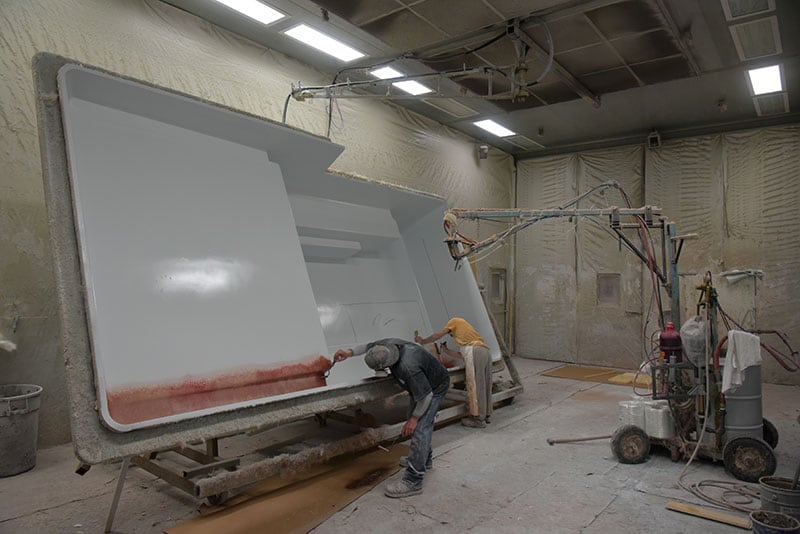
Once the fiberglass and resin has been applied, it’s rolled to remove air pockets, fully saturate the fiberglass with resin, and evenly spread the resin for optimum strength and quality. In the above photo you can see the team working with small hand rollers in the tighter areas of the mold.
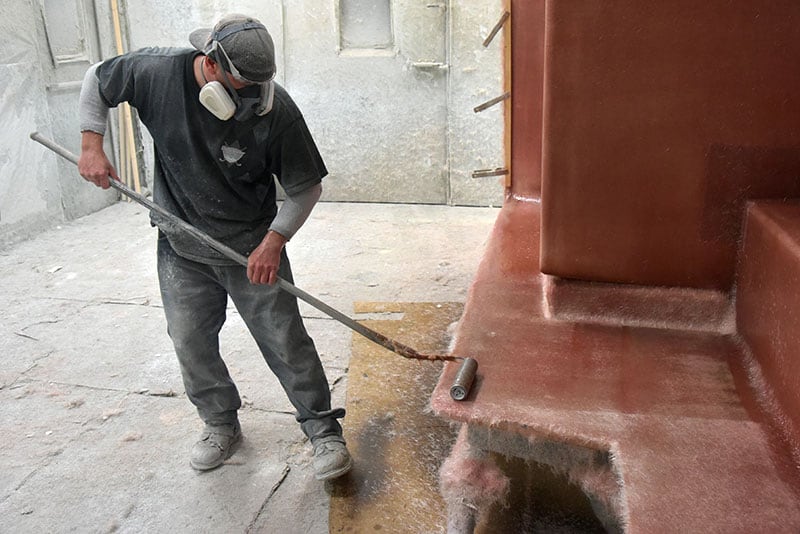
As the fiberglass and resin is applied to the sidewalls of the mold, the second operator uses a larger roller. This was performed with the same steady motion as the gel coat and fiberglass application.
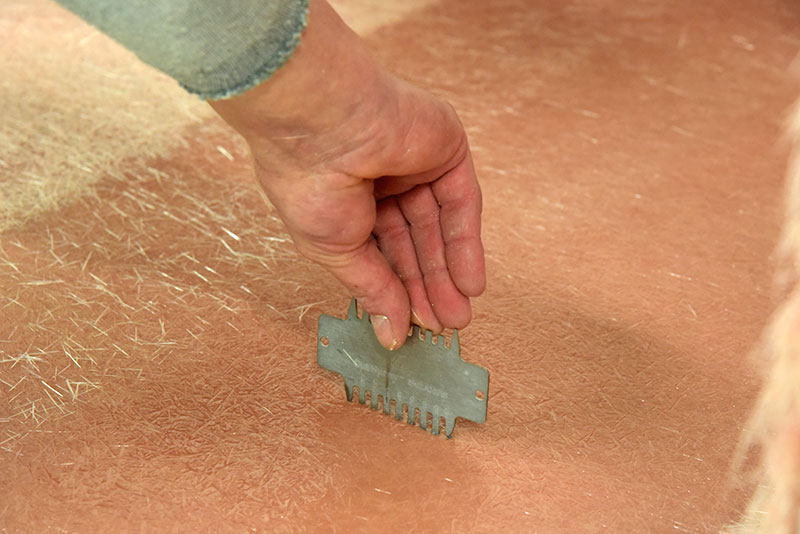
Every few minutes the second operator also verified the thickness of the rolled fiberglass and resin with a gel coat thickness gauge. The teeth on this tool are designed to measure the wet thickness of the fiberglass and resin for repeatable results.
THE GLASS SECRET
The title of this article is, “The Glass Secret”. That secret is contained within the lower mold of Bigfoot’s fiberglass shells.
What’s the secret? We were asked not to reveal the exact nature of the undisclosed materials and process, but we can explain exactly what it does; dramatically strengthens the basement, floor and tie-down structure of a Bigfoot truck camper. As Grant explains it, they essentially put an I-beam into their basement structure, and that’s just one part of the secret sauce.
The result is a time-tested and proven molded fiberglass camper shell designed for off-road use and longevity. To the best of our knowledge, no other fiberglass RV company uses this combination of materials and techniques to strengthen their shells. It’s Bigfoot’s glass secret.
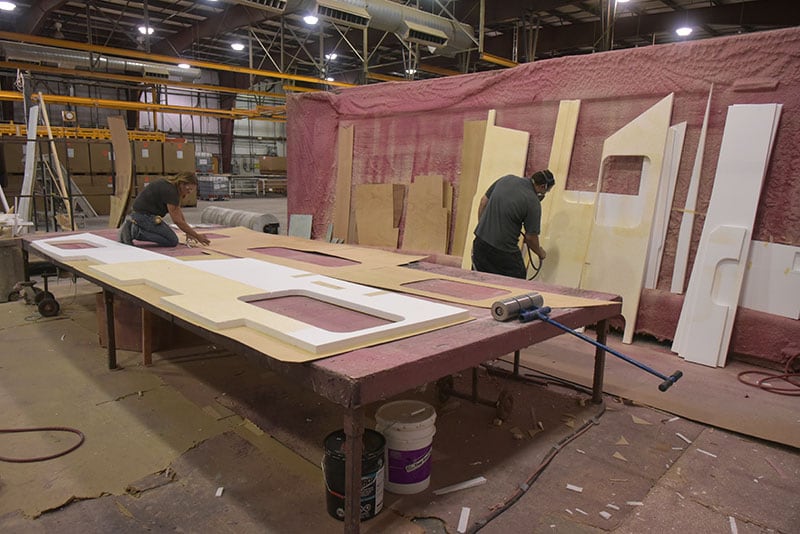
The interior wall and closed cell insulation panels are assembled in the fiberglass shop. The yellow and pink colors are from the different adhesives used during this process.
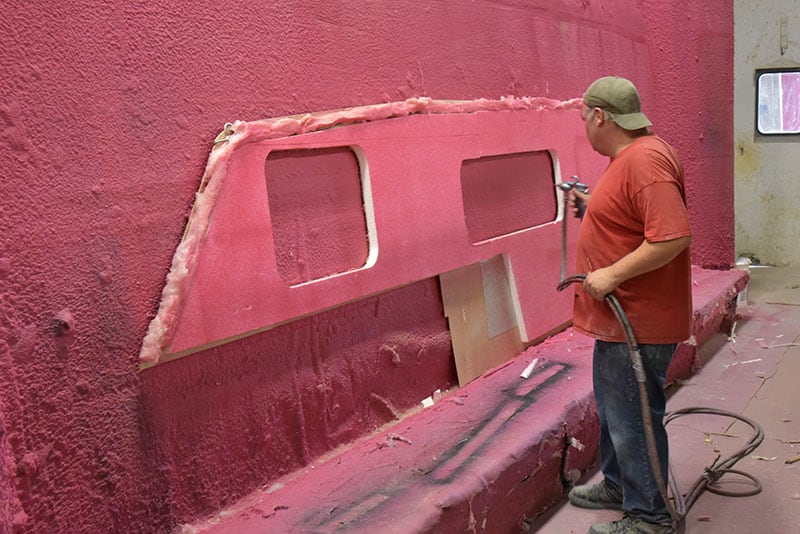
Once the fiberglass team has completed spraying a mold and it has properly set, the mold is brought into an adjacent spray booth. Then the insulated interior wall panels are coated with adhesive and prepped for installation into the mold.
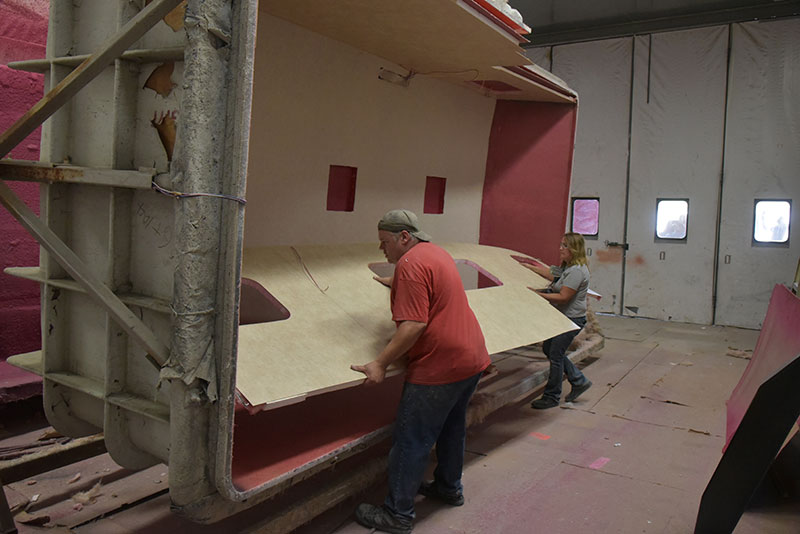
The insulated interior wall panels are light enough to be picked up and positioned by a two person team. Here you see the driver’s side insulated wall panel being inserted into the mold. The passenger’s side and ceiling panels have already been installed.
After the panels are positioned, they are pressed to ensure proper contact and adhesion with the fiberglass shell. This includes carefully hitting the panels with a rubber mallet and wood panel to evenly distribute the pressure. The Bigfoot team calls this process, “pounding”.
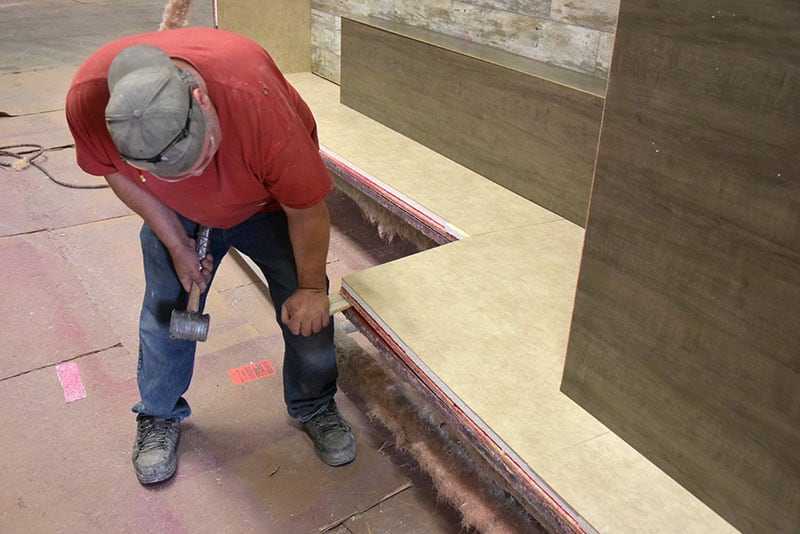
When the bottom fiberglass shell, panels and floor are completed and fully cured, it’s time to release the shell from the mold. This begins by introducing compressed air into a series of holes on the back side of the mold. The compressed air pops the fiberglass shell away from the mold.
While the compressed air is being introduced, the rubber mallet returns to carefully separate inside edges from the mold using a wedge. With the mold blocking their ability to see one another, the team calls back and forth to communicate which parts of the shell have released and which need additional compressed air and mallet strikes.
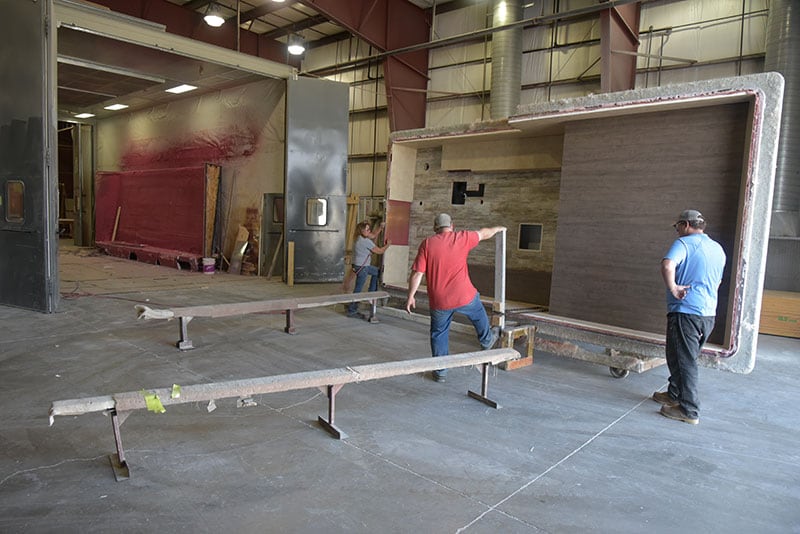
When the shell has fully separated from the mold, the team levers the shell further away from the mold. This step brings the shell out about six-inches.
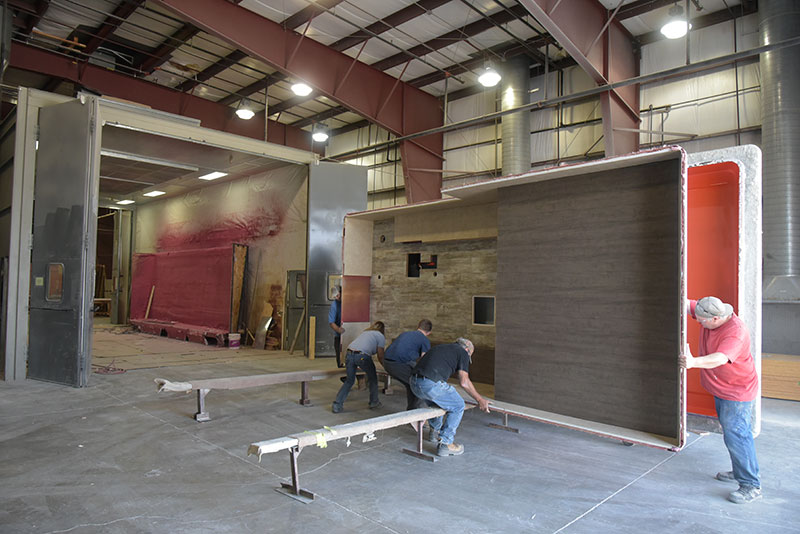
Three more team members join the crew to pull the shell onto a set of stands.
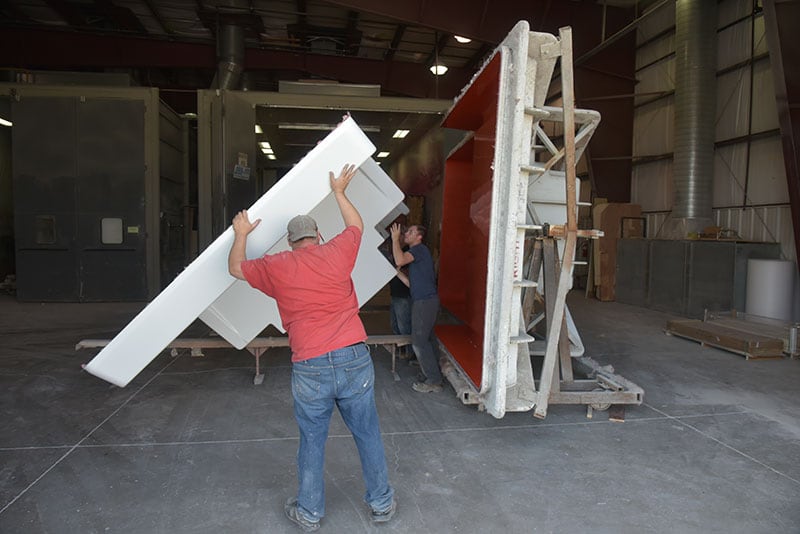
When the shell is far enough from the mold, the team of five tilts the shell down and onto its base.
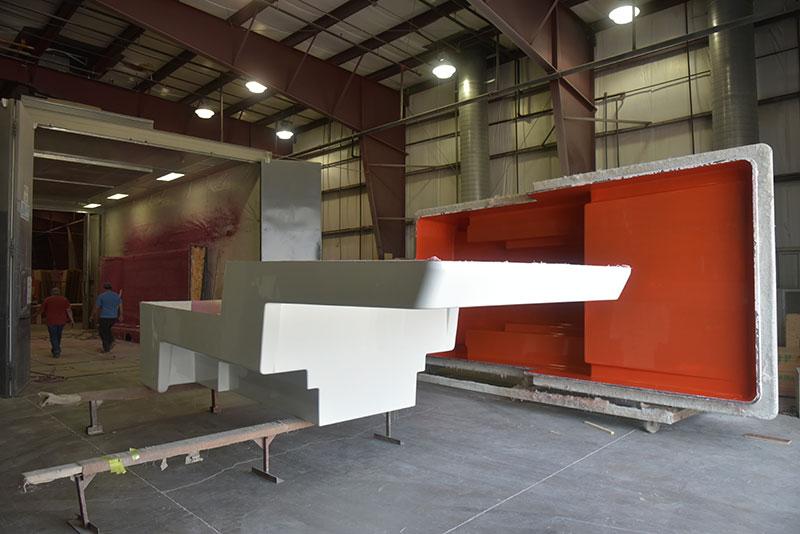
It may be old hat for the Bigfoot team, but we can’t get enough of the stunning beauty of a completed fiberglass camper shell. The entire underside of this fiberglass shell has no seams or screws. Not one. And it’s 100-percent impermeable to water. It could probably float on the nearby Okanagan Lake.
Having experienced, tested, and worked with every truck camper type on the planet, molded fiberglass is the best way to build a truck camper for ultimate longevity. Period. End of story. This is it.
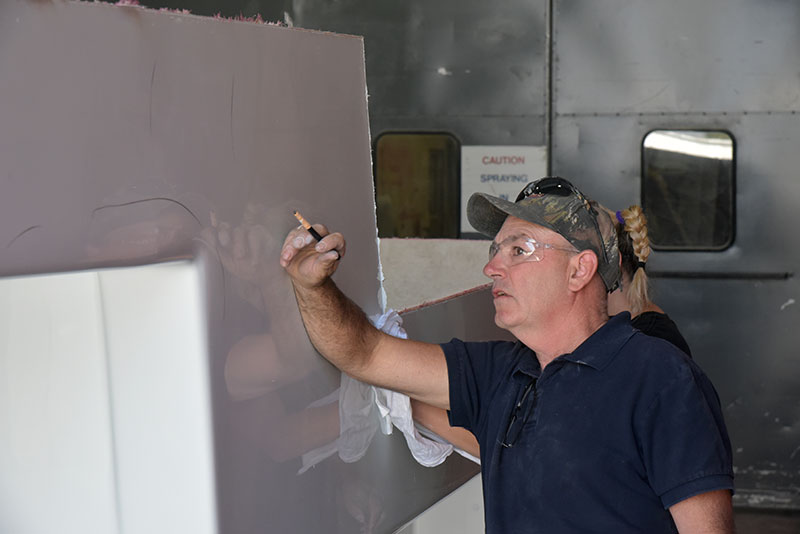
A few moments after the shell was separated, it was inspected by Rob Ferroux, Production Manager for Bigfoot Industries. Rob has been with the company since 1984 and started inspecting Bigfoot campers and trailers in the late 1990s. During our three days at Bigfoot, we watched Rob inspect every aspect of the production line and final product.
Rob marked any imperfections in the gel coat with a grease pencil to be buffed out. Most of the imperfections had to be pointed out to be noticeable. Grant, Rob and the Bigfoot production team are unwavering in their commitment to quality.
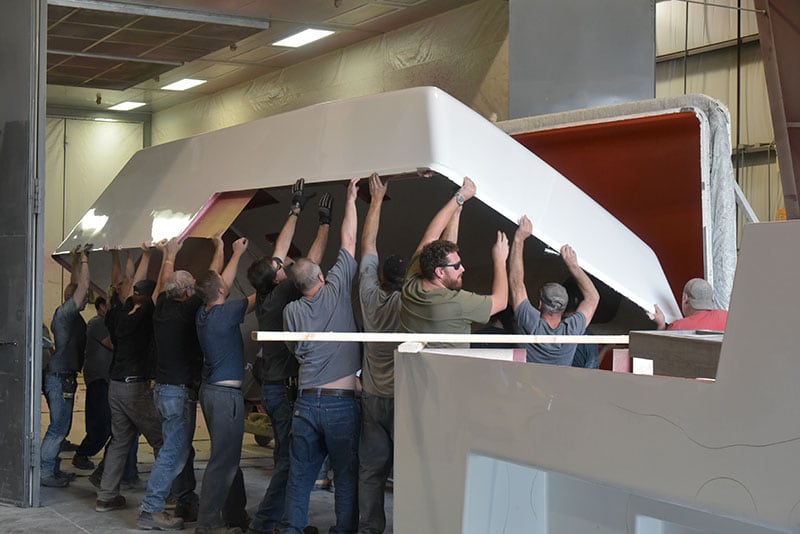
The top shell separation begins with the same compressed air and mallet/wedge process as the bottom shell, but that’s where the similarities end.
When the top shell is popped away from its mold, over a dozen Bigfoot team members from the production line join the effort. The shell is then tilted down and lifted up from all sides.
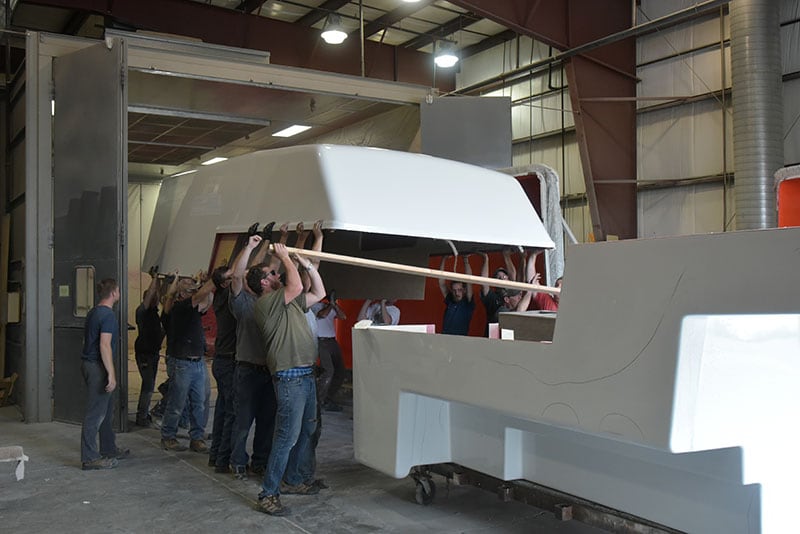
The top shell is then literally walked over to the bottom shell.
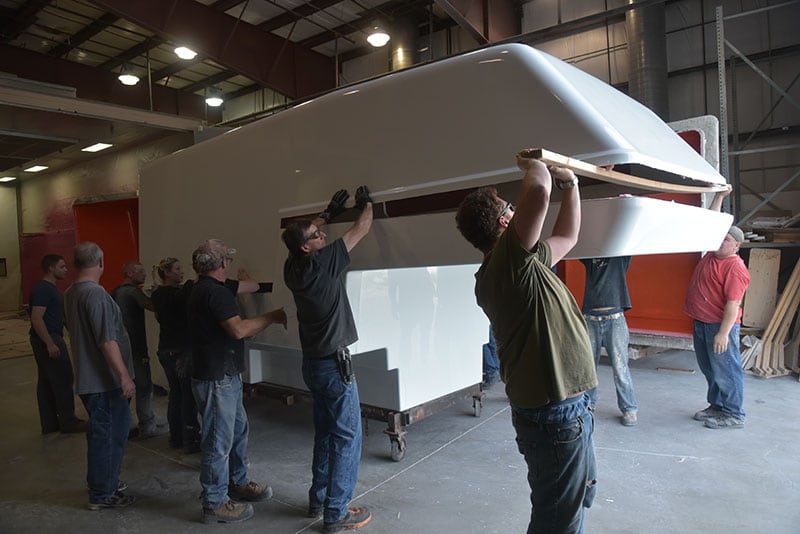
The front nose was held up with wood beam as the team checked and rechecked the alignment back to front. The entire shell marriage took about five minutes.
Some folks might be wondering if they needed over a dozen team members from the production line for this ceremony. After all, the bottom shell was moved by just five people. Grant explained that here there were a number of extra Bigfoot team members who wanted to be part of the Truck Camper Magazine photography. Hey, they read TCM too!
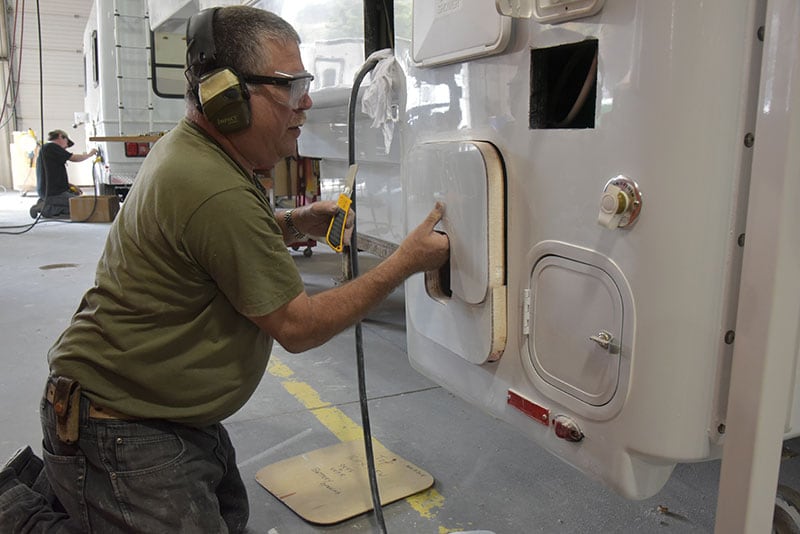
Before we move on, there’s another important detail about molded fiberglass truck campers that warrants attention. Here you see a fiberglass shell cut-out for a rear compartment on the production line. Note the thickness of the gel coat, fiberglass and closed cell high-density foam insulation.
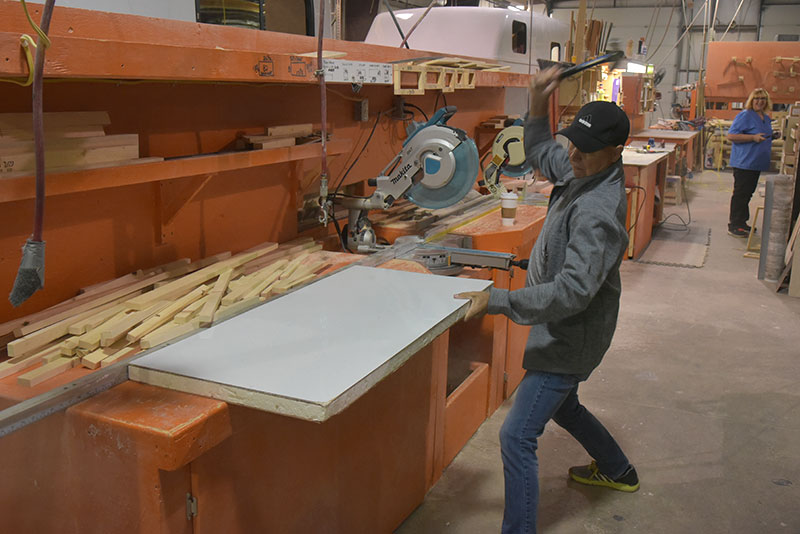
When we first visited Bigfoot Industries back in 2007, Wolf Ernst, then the Sales Manager for the company, insisted that we take a steel claw hammer to a section of Bigfoot’s fiberglass wall. We did, but not to Wolf’s satisfaction who proceeded to hammer the living heck out of the wall. Only when he hit the wall on the hammer edge at full force did he manage to make a mark. We were gobsmacked.
Eleven years later, Grant was back with the steel claw hammer. Grant tried to send the poor wall panel through the concrete floor. As it was in 2007, the only mark Grant could muster was on the hammer’s edge. To say this is an impressive demonstration of the incredible strength of a Bigfoot’s fiberglass shell is an understatement. Do not try this with any other type of truck camper, or truck for that matter.
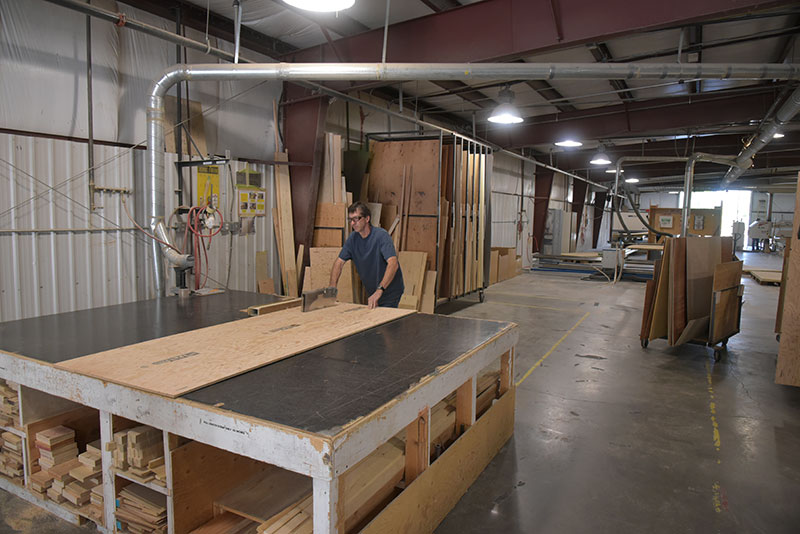
In a building connected to the main production line, one sawyer prepares all of the wood, aluminum honeycomb core, and closed cell foam insulation materials for the fiberglass, cabinetry, and production teams.
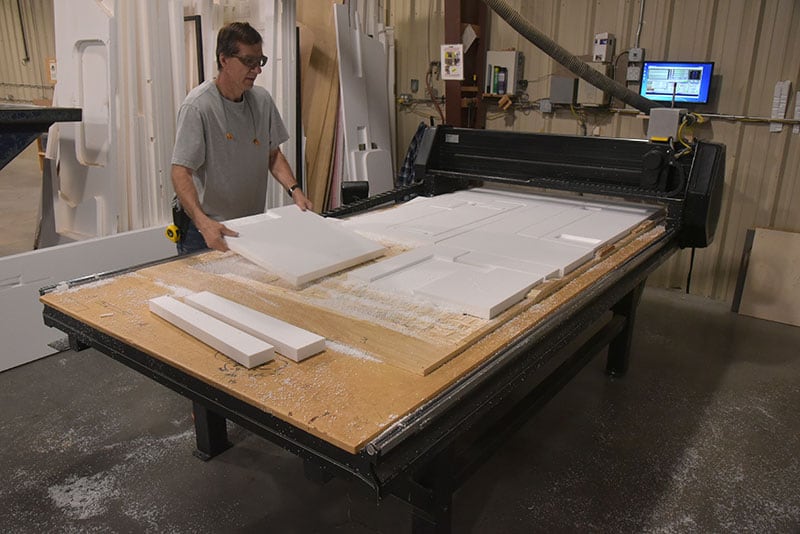
Another stand out memory from our visit to Bigfoot Industries in 2007 was the CNC cut closed cell foam insulation. Where every other truck camper manufacturer was cutting their closed cell foam with utility knives and hot wires, Bigfoot was using a CNC machine.
At the time, this practice was way ahead of every truck camper manufacturer in North America. Even today, very few RV manufacturers employ CNC equipment to cut their insulation and wire traces. Utility knives and hot wires are still the norm in most plants.
That same CNC machine is still in use at Bigfoot Industries. The computer and software have been completely updated, but the table and CNC machine itself are the same. And they’re still ahead.
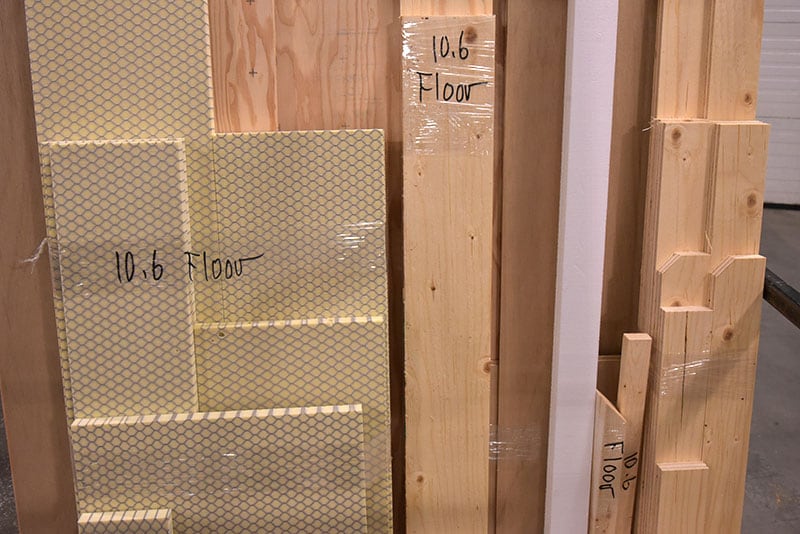
Once the wood, honeycomb core, and closed cell insulation materials have been prepared, they are bundled, labeled, and carted. This particular set is for a Bigfoot 25C10.6E truck camper.
The aluminum honeycomb core is incredibly strong and lightweight. The material does not take a screw, but it’s ideal for floors and other structural elements. It’s also cut on the same table saw as the wood products.
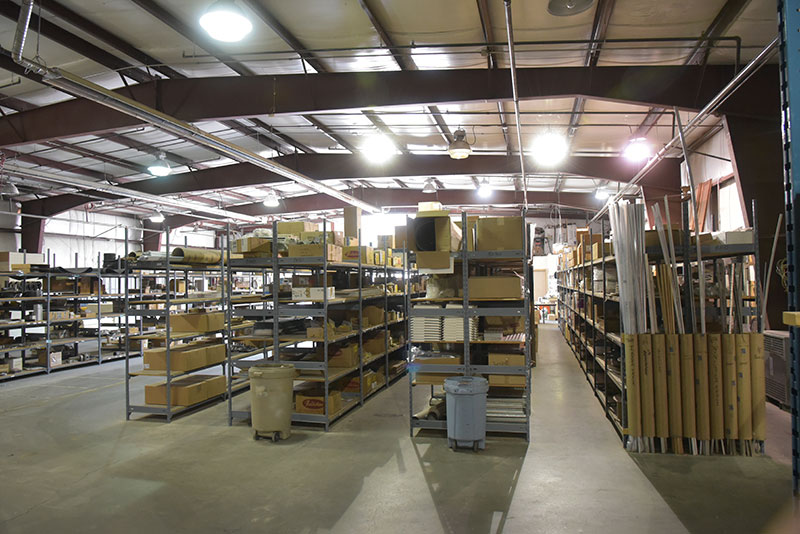
Bigfoot Industries has an entire building devoted to parts and material inventory for the production line and service. This photograph was taken from the center of the inventory building and only shows half of the parts and materials on hand.
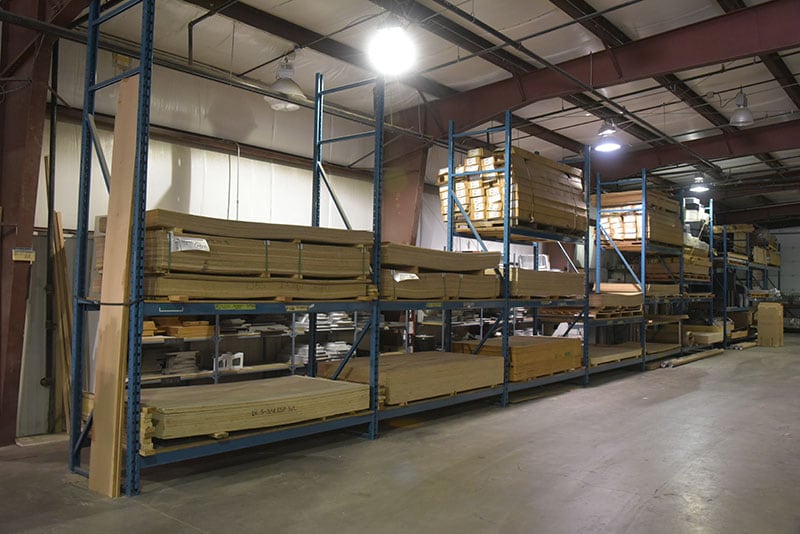
Turning around we discovered plywood, awnings, holding tanks, Heki vents, cabinetry doors and a myriad of other parts, components, and materials. Essentially, everything that’s needed to build a Bigfoot truck camper after the shells are completed is here.
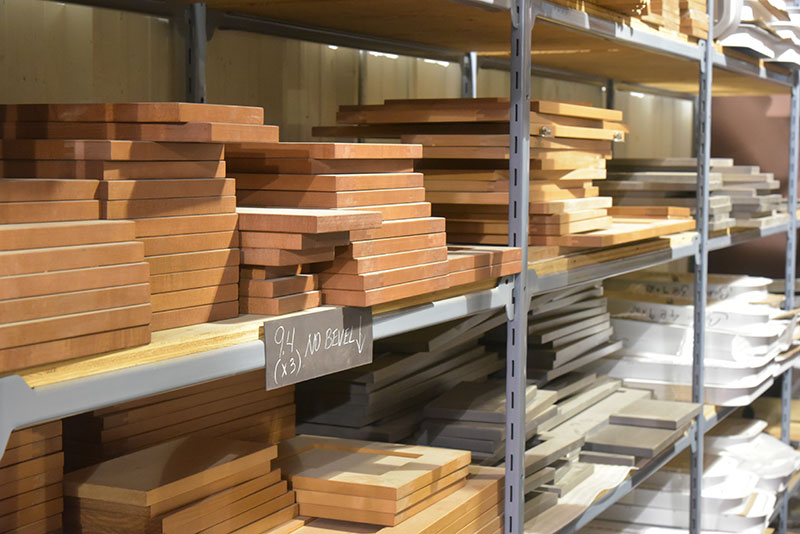
The most impressive aspect of the inventory building is the organization. Every item is in a designated area on a clearly labeled shelf. Which turns our wayback machine on yet again…
12 years ago Bigfoot Industries was the only truck camper manufacturer seriously pursing Lean Manufacturing (aka The Toyota Way). Other truck camper companies had adopted various aspects of Lean Manufacturing, but Bigfoot had sent its leadership team for extensive training and executed Lean Manufacturing company wide in 2007.
Lean Manufacturing at Bigfoot Industries continues today under Grant’s leadership. Grant himself was Lean Blackbelt Certified in 2005. As President of the company, Grant continues to weave the concepts of Lean Manufacturing into the cultural fabric of the business. Lean is evident everywhere you look at Bigfoot, including the inventory building.
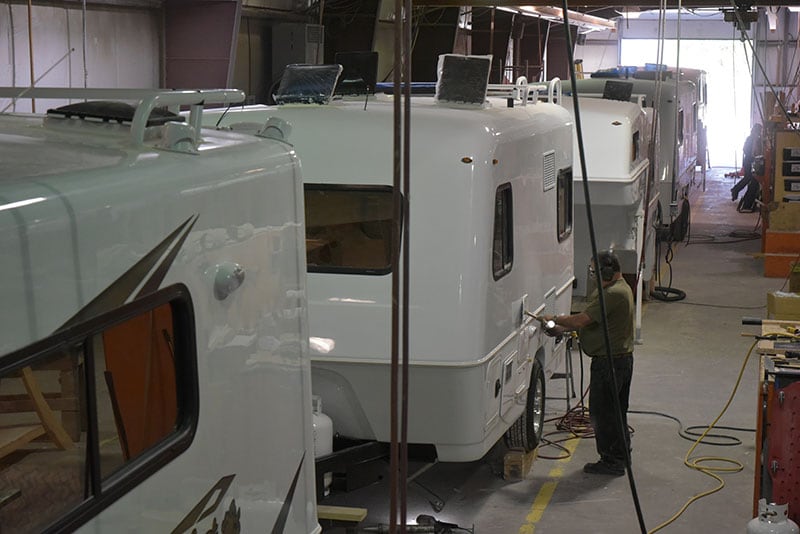
Bigfoot Industries currently has one production line for both truck campers and travel trailer products. Here you see truck campers and trailers alternating down the line.
The alternating of campers and trailers was just how the production line was stacked during our visit. Bigfoot schedules and builds campers and trailers as they are ordered by their dealer network.
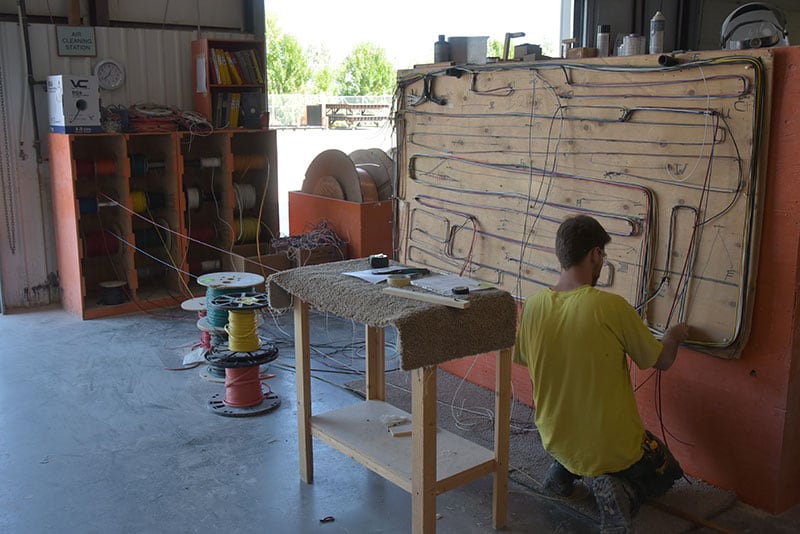
Immediately off to the side of the production line is where the wiring harnesses, plumbing harnesses, cabinetry and other production components are assembled and prepared.
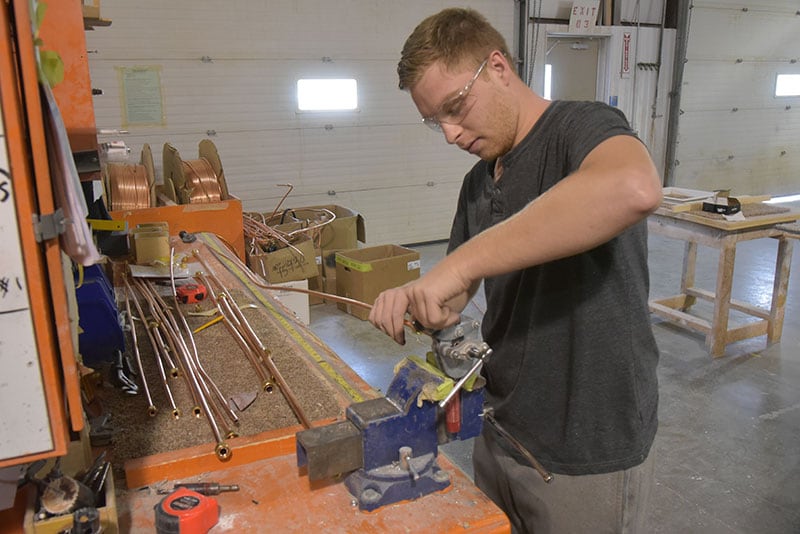
These copper gas lines are being assembled on the other side of where the wiring harnesses are made. All of Bigfoot’s wiring harnesses and copper gas lines are manufactured in-house.
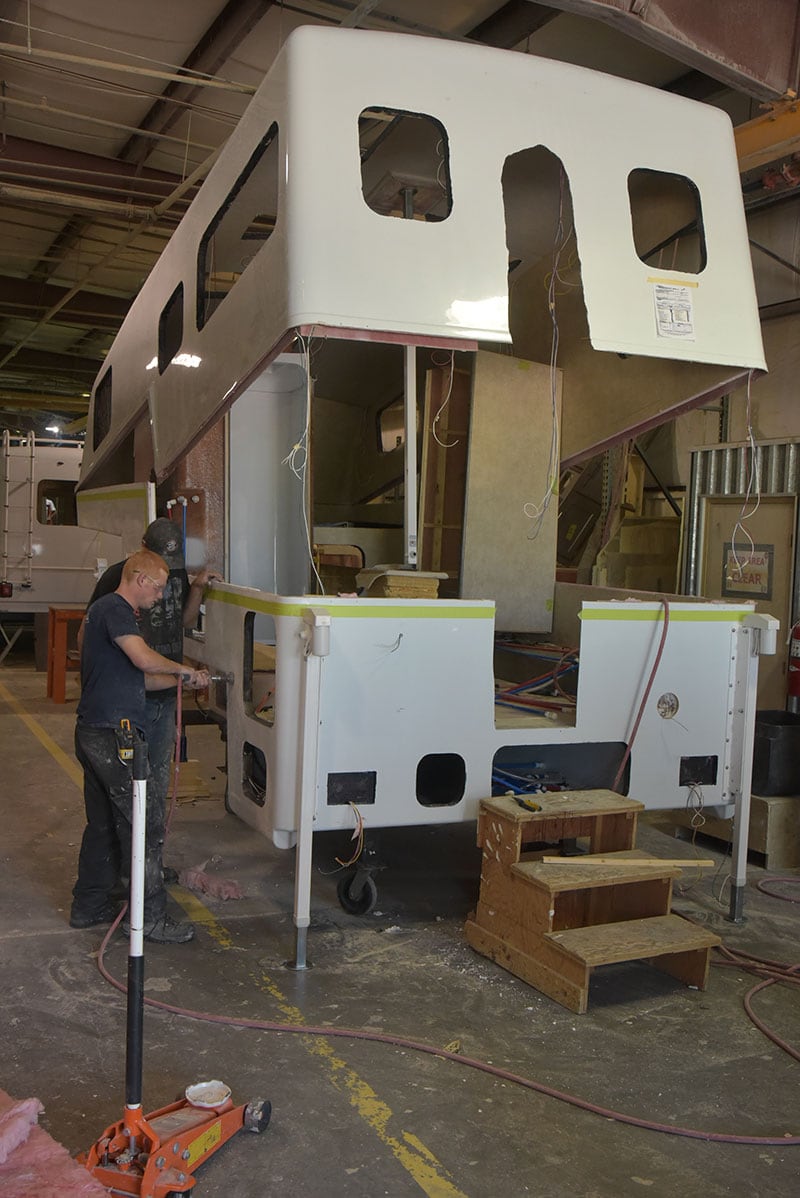
Completed top and bottom camper shells are delivered from the fiberglass shop to the production line for finishing. Finishing includes cutting out the windows and compartment door openings and affixing the two shells with sealant and belt molding.
Before the sealant is applied, the two shells are separated with a Happijac camper jack set inside the unit. This allows the shell seam to be cleaned and prepared before the sealant is applied and the two halves are permanently affixed.
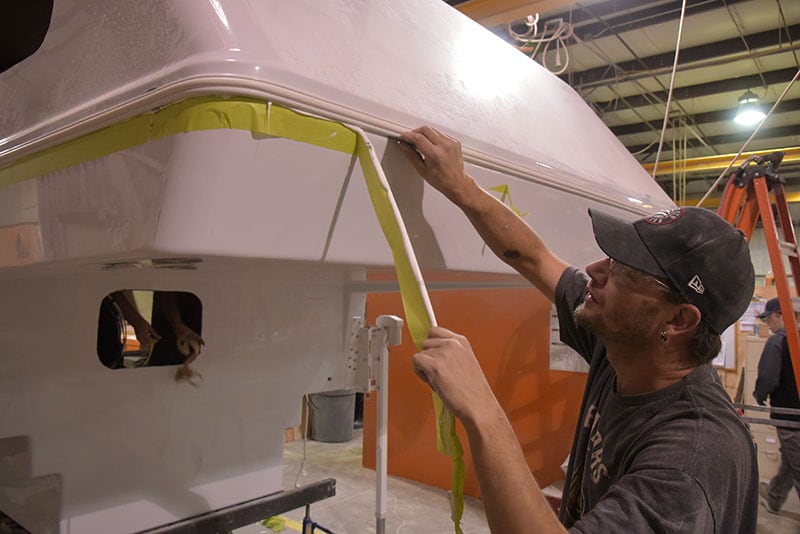
Part of the prep work includes applying painter’s tape to avoid excess sealant from oozing onto the lower shell. This is one of the final fiberglass shell steps before the camper interior begins to take shape.
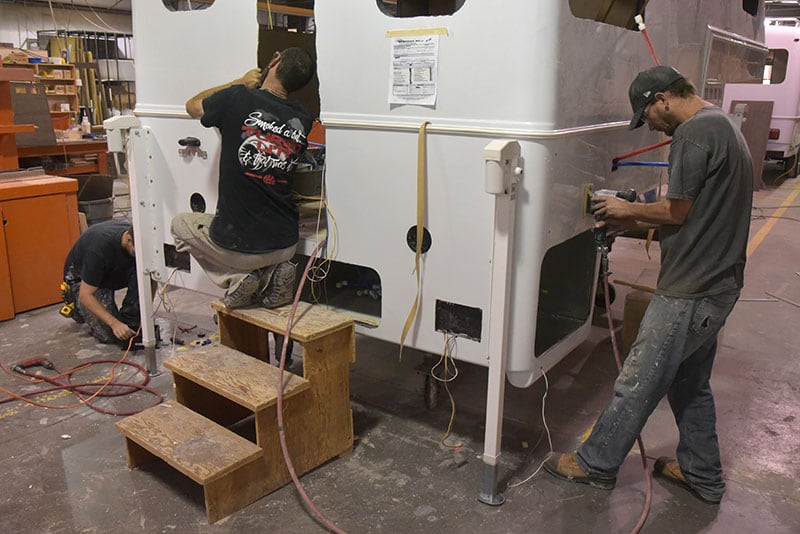
With the fiberglass shell completed, the production line team kicks into overdrive. Here you see the wiring and plumbing systems being installed at the first station.
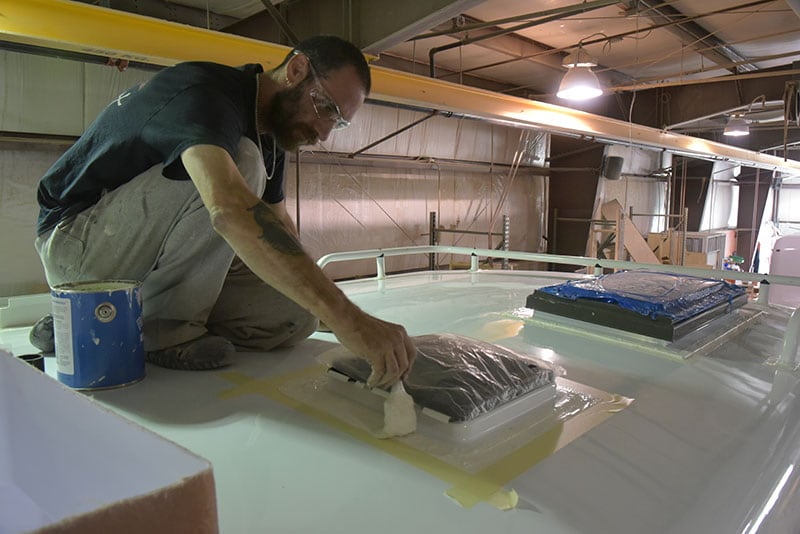
We were very interested to see how Bigfoot applies the Plasti-Cote roof sealant on the production line. Where nearly the entire RV industry uses Dicor self-leveling roof sealant, Plasti-Cote is designed for fiberglass surfaces and is applied with a 2-inch brush.
For clean lines, Bigfoot tapes off the roof surface. When the tape is removed, it leaves a perfectly straight line of Plasti-Cote material. Grant explained that Bigfoot has been using Plasti-Cote for many years and that it has proven to be highly reliable.
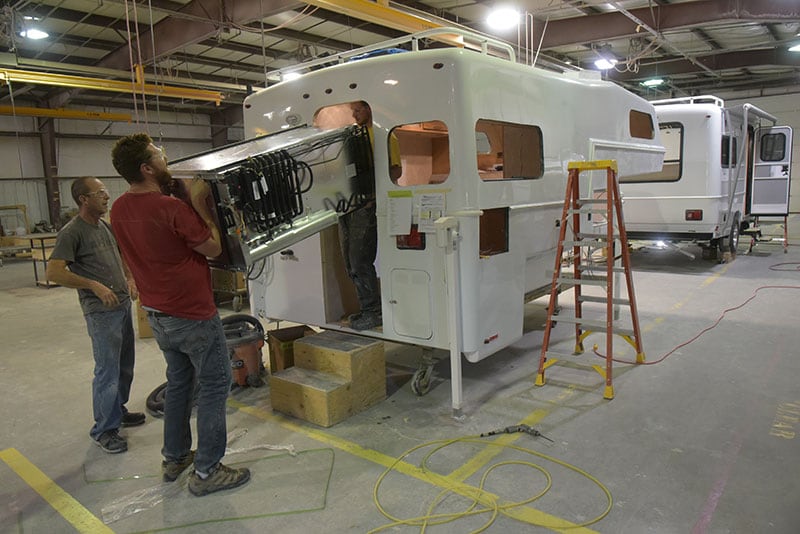
It’s not unusual for refrigerators to be installed into truck campers before the side walls and entry door are completed. In many truck camper designs, there is simply no other way to get the refrigerator into the unit.
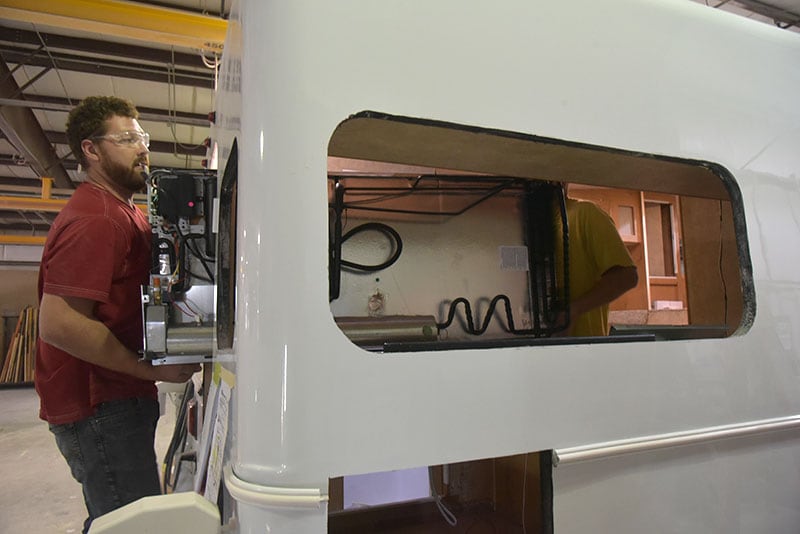
Bigfoot installs refrigerators though the entry door opening before the door is installed. This means refrigerators can be removed and replaced in a Bigfoot truck camper by first removing the entry door. This would not be a minor effort, but it’s more than possible.
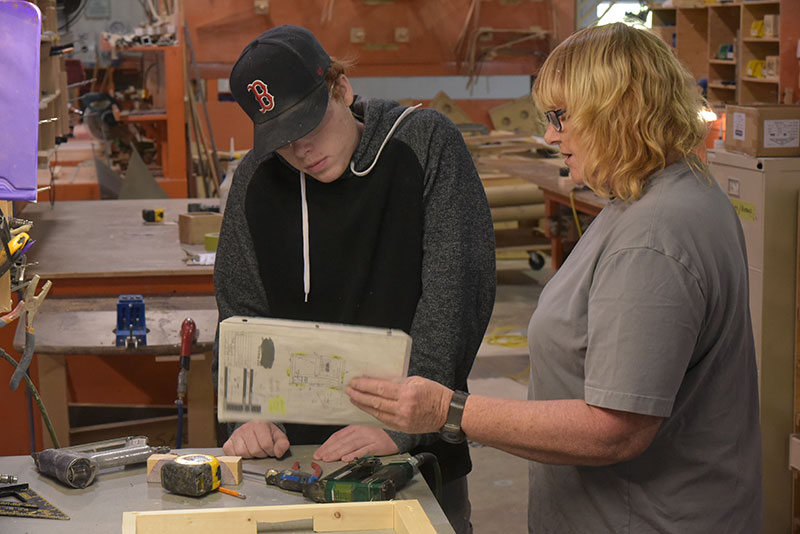
The majority number of Bigfoot team members have been with the company for decades. This traces back to Grant’s keen decision to seek out and hire the best of the best from the original Bigfoot company when he brought the company back eight years ago.
The first people on his list were the folks with the most experience and the highest dedication to the business. When you ask when people first started with Bigfoot, the answer often starts in the 1980s. Simply incredible.
Now you might think that workers with that many years into the business could build the campers blindfolded, with one arm tied behind their back, while wearing a Bigfoot suit. While that is probably true, they all follow and refer to build sheets; even the most senior staff. This practice comes from Lean Manufacturing principals and is actively modeled for new recruits to this day (see above).
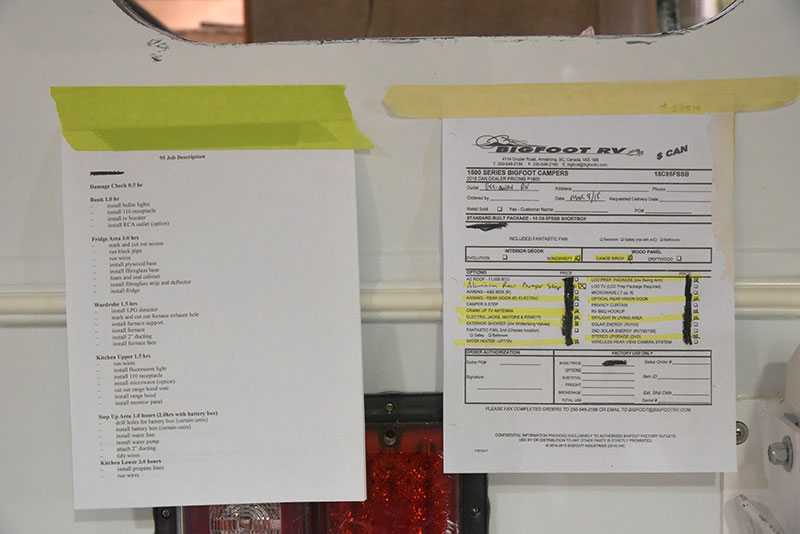
Speaking of sheets, every unit has a set of rider sheets that describe the exact options and interior the dealer and/or customer has ordered. The rider sheets are accompanied by a set of build sheets that detail what needs to happen at each station and exactly how many hours are allocated to the task. More Lean.
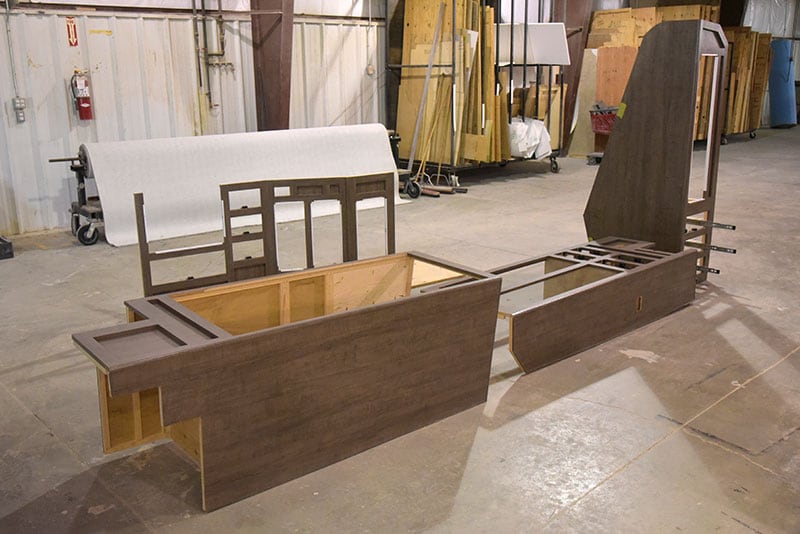
Of everything we saw at Bigfoot that impressed us (and there many things), what impressed us the most was how each and every element of a camper’s interior was painstakingly finessed for a perfect fit – unit by unit.
As an example, Bigfoot cabinetry is built in sets for each camper and set off to the side of the production line. Look closely and you’ll notice there is no plastic gimp (aka welt molding trim) anywhere on this finished cabinetry. Bigfoot does not use gimp.
This is particularly impressive because molded fiberglass truck campers are not perfectly formed with identical wall thicknesses. Hand sprayed, the fiberglass shells vary slightly. This tiny variation makes standardized production cabinetry impossible – without gimp.
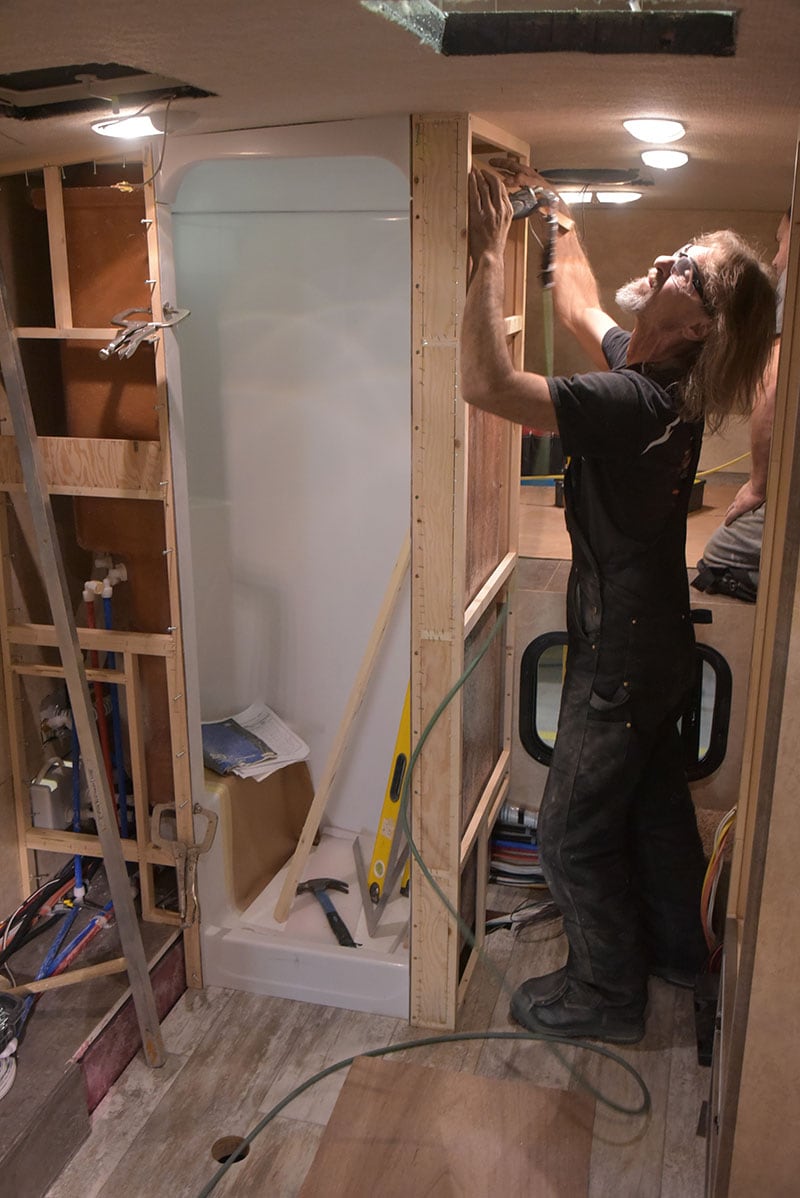
And that’s where skill, experience, Bigfoot’s unrelenting cultural attitude about quality steps in. As each internal component is brought into the camper and installed, it’s checked, measured and adjusted to fit perfectly.
In the case of the 25C10.4 shown above, it starts with the bathroom shower stall. Once that’s installed, checked, measured and adjusted to fit perfectly, the bathroom cabinets are brought in and checked, measured, and adjusted to fit perfectly with it. This continues element by element until every cabinet and component in a unit fits perfectly.
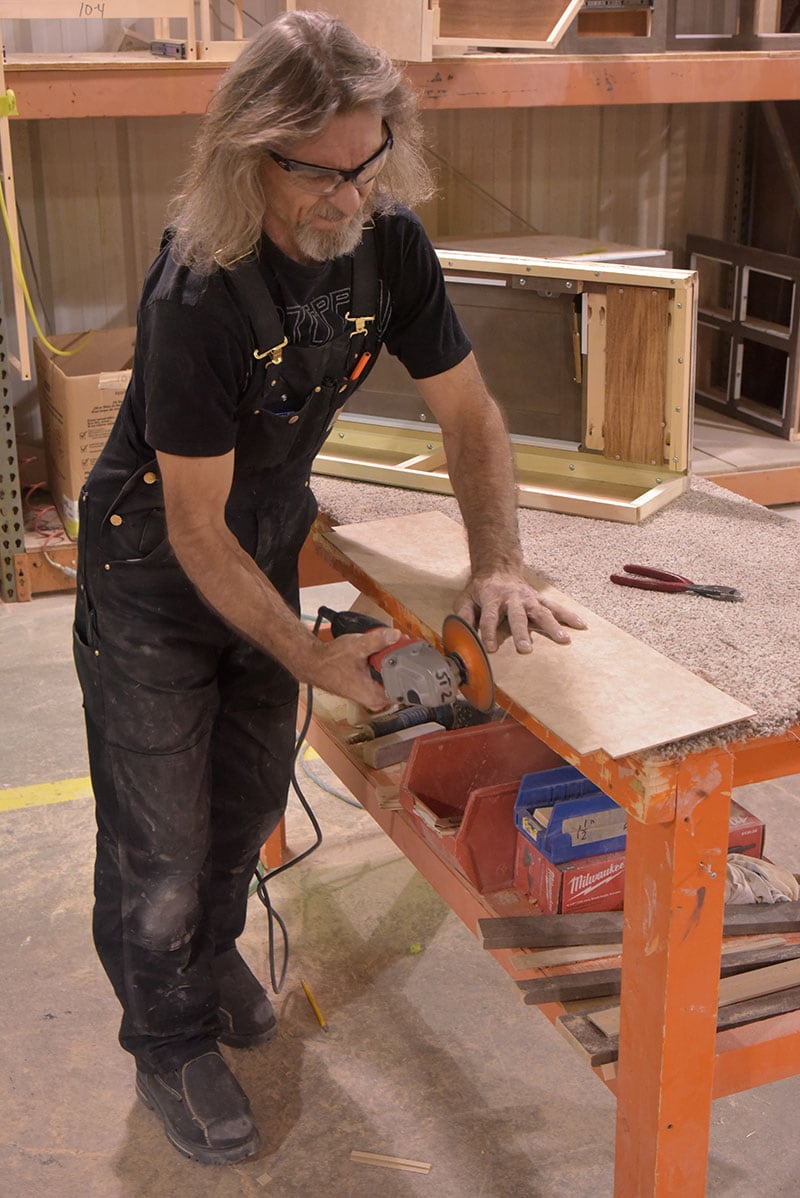
As we watched, pieces were brought out of the unit and shaved a hair here or there before being set into place. This takes a great deal of time, but the results are unmistakable. After seeing so many manufacturers build and install cabinets with gimp to hide tolerance issues, this was stunning to witness.
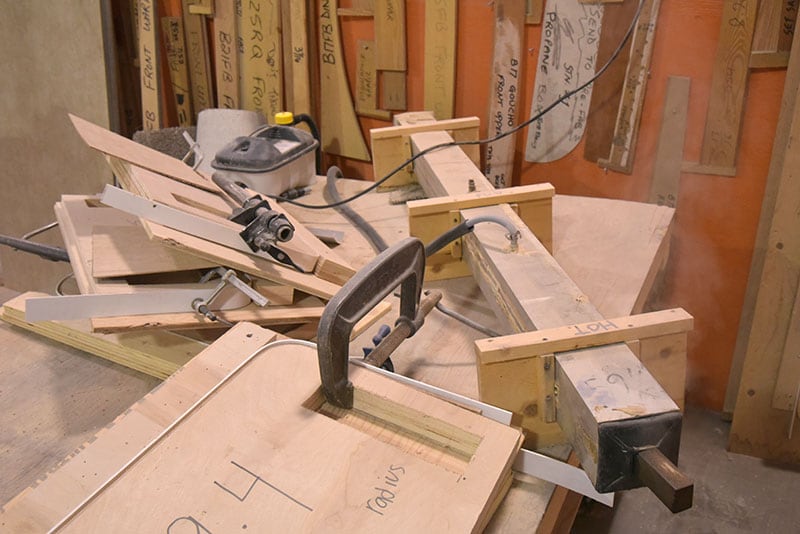
Another over the top example of Bigfoot’s obsession with quality is their steam bent counter and table trims. Starting with a handmade jig, wood banding material is steamed in a steam box (shown center right).
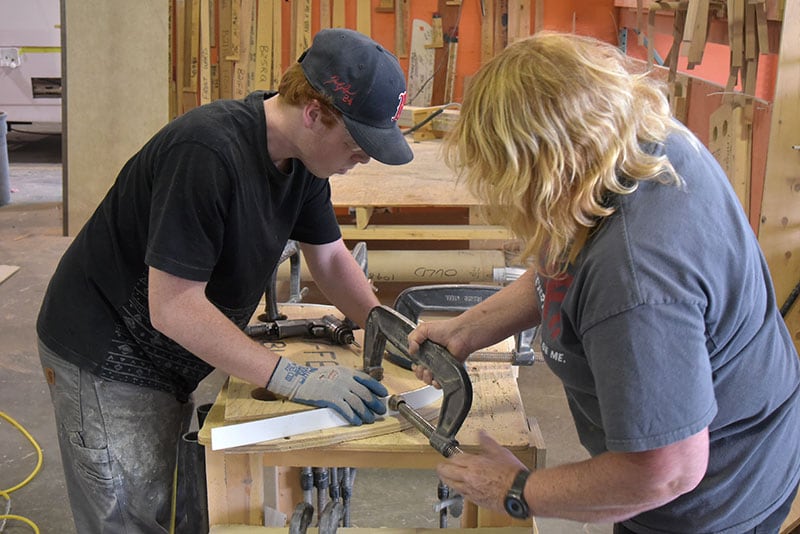
Once the wood trim is brought out of the steam box, it’s quickly set into a custom jig. This process must be done quickly as the freshly steamed wood begins to lose its elasticity in less than a minute. Once installed into the jig, the trim is allowed to set for a full week.
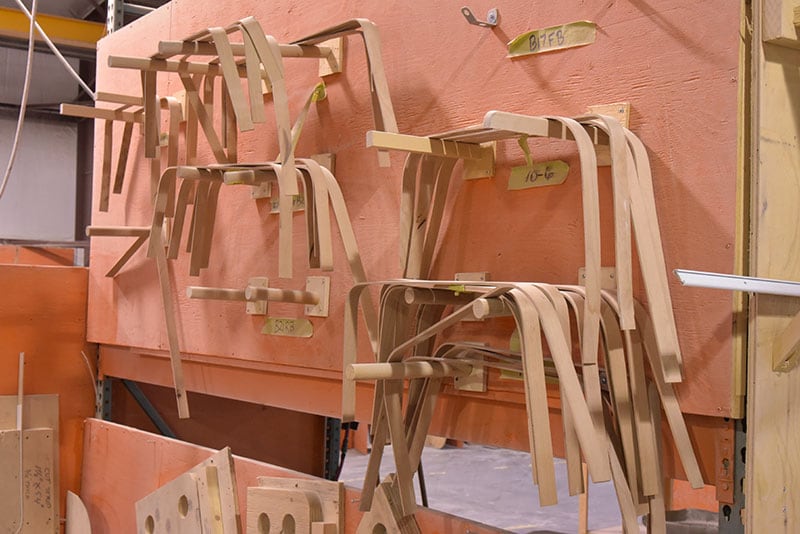
The results of this work are smooth forms ready to make Bigfoot tables and countertop trims the highest quality possible. In all of the truck camper and RV factories we have toured and studied over the past 12 years, we have never encountered steam bent trims.
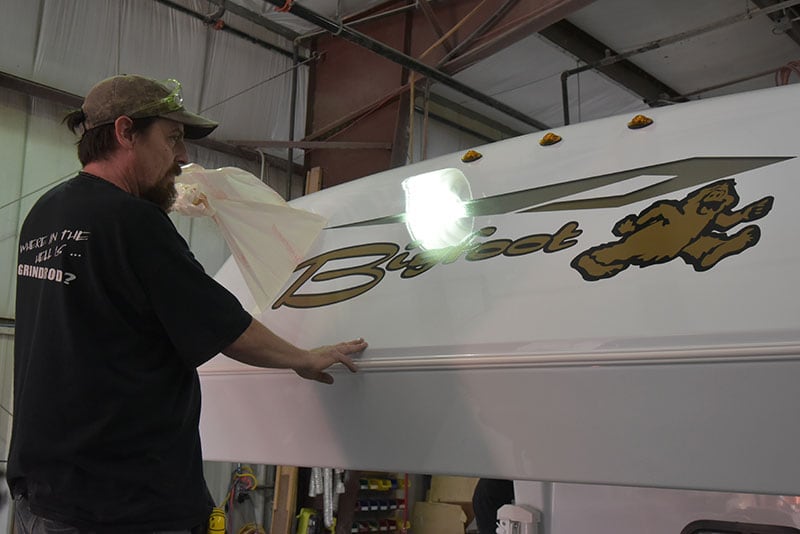
Oh how we love to see the front decal installed on a truck camper. Here the Bigfoot “ape” is revealed for the first time on a 1500-series truck camper. He sure looks happy to be free!
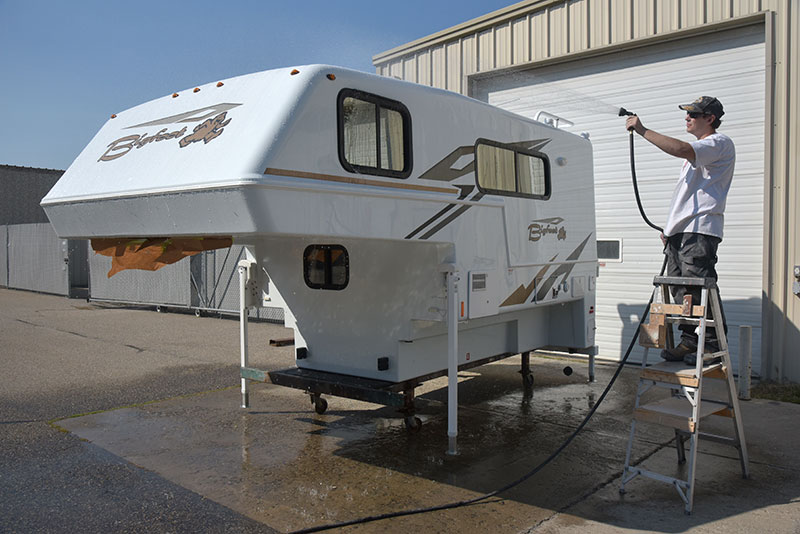
After emerging as a freshly completed Bigfoot from the production line, each camper is water tested for leaks. This involves dousing the unit in water and checking every window, seal, and compartment for signs of water intrusion. In the unlikely event that there’s a leak on a Bigfoot truck camper, the team wants to catch it before it leaves the factory.
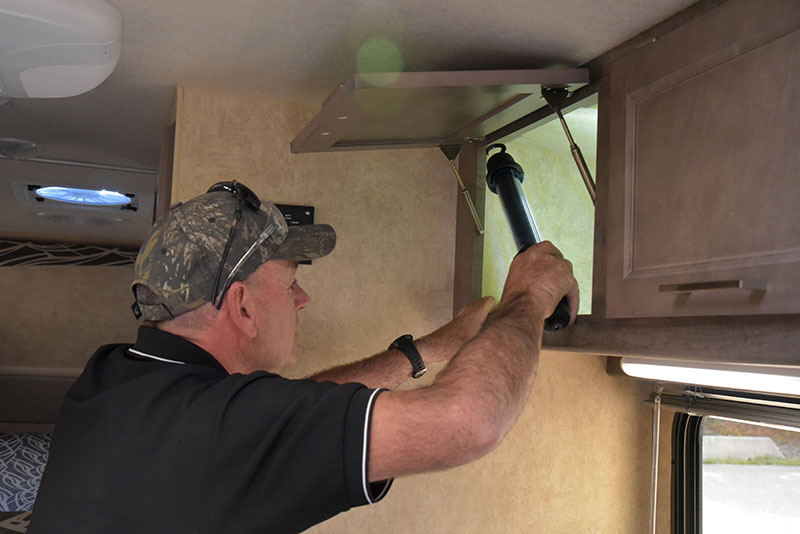
The final inspection for every Bigfoot is performed by Rob. He goes through every cabinet, looks at every plumbing and electrical connection, checks every material and finish, and generally goes through the entire unit with his flashlight – and 30-plus years of Bigfoot manufacturing experience. Did we mention that this team is fanatical about quality?
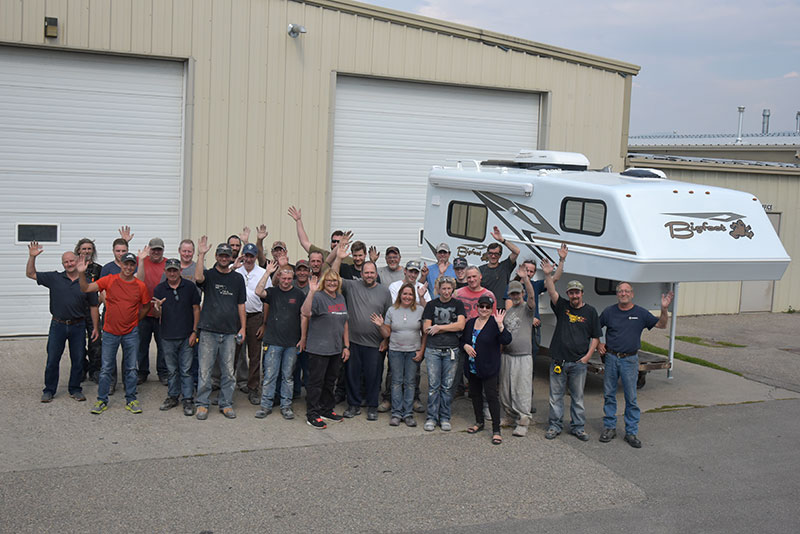
On the final day of our visit, we gathered the entire Bigfoot Industries team together for a group shot; fiberglass, inventory, production, and management.
“It’s either a Bigfoot, or it’s not.”
We now understand what Grant meant by his bold statement. There is an unmistakable dedication at Bigfoot – not just to quality, but a level of quality we truly haven’t seen before.
Grant has made a conscious decision to prioritize quality over volume and profits. Put bluntly, most manufacturers would never create or enforce Bigfoot’s extreme quality standards at the expense of production. For Grant, it’s the only way he wants to run the company.
Bigfoot truck campers and trailers cost more than the competition. All we can say after our time with the Bigfoot team is that you definitely get what you pay for.
For more information on Bigfoot Industries, visit their website at bigfootrv.com. Click here to request a free Bigfoot camper brochure.
